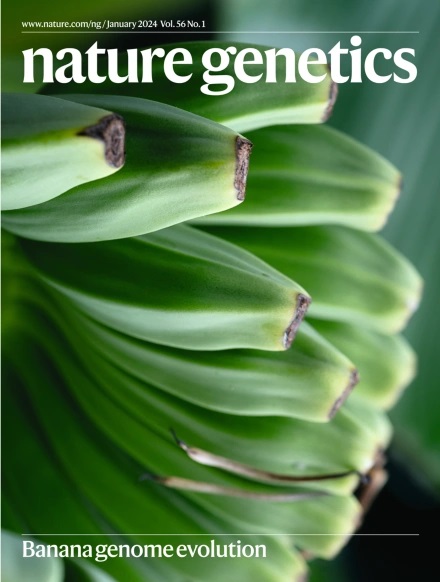A head-to-head NLR gene pair from wild emmer confers stripe rust resistance in wheat
IF 31.7
1区 生物学
Q1 GENETICS & HEREDITY
引用次数: 0
Abstract
Wheat stripe rust poses a major threat to global food security. Discovery of disease resistance genes from wild relatives enables multigene stacking that could enhance durability. Here we use map-based cloning and long-read sequencing to isolate two adjacent nucleotide-binding and leucine-rich repeat (NLR) receptors from wild emmer wheat. Using mutagenesis, gene silencing and genetic transformation, we show that the genes TdNLR1 and TdNLR2 oriented head-to-head are both required for YrTD121-mediated stripe rust resistance. TdNLR1 encodes a canonical NLR (CC-NB-ARC-LRR) protein, whereas TdNLR2 encodes an atypical one (NB-ARC-LRR). Both genes lack an integrated domain previously associated with effector perception, representing an uncommon architecture for paired NLRs in plants. The coiled coil domain of TdNLR1 triggers cell death and self-associates in planta. YrTD121 was present in wild emmer but absent in all other Triticum species examined. Our work sheds light on the function of paired NLRs in conferring disease resistance and facilitates breeding for resistance. Two genetically linked TdNLR genes from wild emmer wheat are both required for YrTD121-mediated stripe rust resistance. The TdNLR1 and TdNLR2 pair lacks an integrated domain, representing an uncommon architecture for paired NLRs in plants.


来自野生二聚体的首尾NLR基因对赋予小麦抗条锈病能力
小麦条锈病对全球粮食安全构成重大威胁。从野生近缘种中发现抗病基因,使多基因堆叠能够增强耐久性。本研究利用基于图谱的克隆和长读测序技术从野生二粒小麦中分离出两个相邻的核苷酸结合和富亮氨酸重复序列(NLR)受体。通过诱变、基因沉默和遗传转化,研究人员发现,yrtd121介导的条锈病抗性需要TdNLR1和TdNLR2两个头对头的基因。TdNLR1编码一个典型NLR (CC-NB-ARC-LRR)蛋白,而TdNLR2编码一个非典型NLR (NB-ARC-LRR)蛋白。这两个基因都缺乏先前与效应感知相关的集成结构域,这代表了植物中成对nlr的罕见结构。TdNLR1的螺旋结构域触发植物细胞死亡和自结合。YrTD121在野生小麦中存在,但在所有其他小麦品种中均不存在。我们的工作揭示了配对nlr在赋予疾病抗性和促进抗性育种中的作用。
本文章由计算机程序翻译,如有差异,请以英文原文为准。
求助全文
约1分钟内获得全文
求助全文
来源期刊

Nature genetics
生物-遗传学
CiteScore
43.00
自引率
2.60%
发文量
241
审稿时长
3 months
期刊介绍:
Nature Genetics publishes the very highest quality research in genetics. It encompasses genetic and functional genomic studies on human and plant traits and on other model organisms. Current emphasis is on the genetic basis for common and complex diseases and on the functional mechanism, architecture and evolution of gene networks, studied by experimental perturbation.
Integrative genetic topics comprise, but are not limited to:
-Genes in the pathology of human disease
-Molecular analysis of simple and complex genetic traits
-Cancer genetics
-Agricultural genomics
-Developmental genetics
-Regulatory variation in gene expression
-Strategies and technologies for extracting function from genomic data
-Pharmacological genomics
-Genome evolution
 求助内容:
求助内容: 应助结果提醒方式:
应助结果提醒方式:


